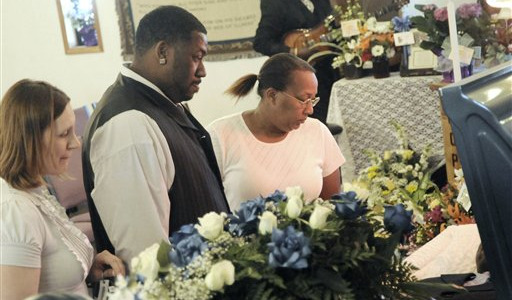
BEAVER, W.Va. (AP) – Federal investigators say they have proof that Massey Energy kept fake safety records to throw off inspectors at a West Virginia coal mine where 29 men died last year, the deadliest U.S. coal field disaster in four decades.
In a private briefing June 28, officials with the Mine Safety and Health Administration showed relatives of the Upper Big Branch miners side-by-side comparisons of books that purported to document the same shift. The agency was holding a public news conference on its findings Wednesday.
In one authentic report, Massey recorded that a mining machine was shut down because of problems with ventilation and a potentially explosive accumulation of methane gas. The on-shift inspection report, meanwhile, indicated no problems with gas, said underground miner Bobbie Pauley, whose fiance Howard “Boone” Payne was among the men killed in the April 5, 2010, blast near Montcoal in southern West Virginia.
“You put in an inspection report what you wanted the inspectors to see,” Pauley said. “The books, they told two different stories. But I already knew that because I worked there.”
Massey was bought by Alpha natural Resources this month. Alpha spokesman Ted Pile said Wednesday the company was hearing about the faked reports for the first time.
“It’s a claim I’m sure we’ll look into as we conduct our own review of what happened at Massey’s Upper Big Branch mine.” Pile said in an email.
Pauley returned to Upper Big Branch only briefly after the explosion and now works at another former Massey operation bought out by Alpha. She was among about 30 people – nearly half of them lawyers – who attended the briefing for several hours at a mine safety training academy in Beaver.
A public presentation for MSHA’s latest findings was set for Wednesday morning. But Pauley and two other relatives, Gary Quarles and Clay Mullins, said the federal team offered nothing new and pushed back the timeline for completion of its final report for at least four more months. They’ll now have to wait until October, at the earliest, for a comprehensive report.
The explosion remains the subject of a criminal investigation by the U.S. Department of Justice, and MSHA has said it won’t release some information to avoid hindering that probe. It largely reiterated its past public statements, offering detail but no blockbuster revelations, family members said.
MSHA contends the explosion started with a small, naturally occurring release of methane gas that was then fueled by coal dust into a devastating inferno that tore through the mine in a series of explosions over a few minutes. The agency has blamed a poorly maintained cutting head on a piece of mining equipment for sparking the blast and a malfunctioning water sprayer for failing to douse it.
An independent investigation commissioned by former Gov. Joe Manchin reached the same conclusion last month.
Mullins, whose brother Rex died in the blast, said he was frustrated that MSHA continues to blame Massey for the well-documented and serious safety problems at Upper Big Branch, rather than accepting blame for its own failures.
“It’s a finger-pointing game: ‘It’s your fault. It’s this guy’s fault,'” he said. “This whole thing has been very frustrating. We didn’t learn anything new.
“Massey didn’t do their job, providing these men with a safe work area. MSHA didn’t do their job by enforcing the law and making them provide the men with a safe working environment. Same with the state. I blame all three parties,” Mullins said. “And I still do. And I will, until the day I die.”
Although MSHA acknowledged it needs to do better, he said, it stopped short of apologizing.
“I think they know they’re a guilty party in this, too,” he said. “They didn’t say it that way, but they know.”
Manchin’s study blamed former owner Massey Energy for ignoring the most basic safety practices in the industry, allowing highly explosive coal dust and methane gas to accumulate when it failed to provide either enough fresh air flow or enough pulverized limestone on the mine’s walls to render coal dust inert.
MSHA offered some more detail Tuesday, Pauley said, “but the bottom line is the same: It was preventable. It didn’t have to happen.”
Quarles said the history of violations spoke for itself. MSHA knew there were problems at Upper Big Branch, he said. Inspectors were in the mine the day of the blast and did nothing.
“Somebody should have stepped up and said we need to take a better look at this mine and, if we have to, go in and shut it down,” he said.
“I thought this meeting would give us quite a bit more, and then in a month that it would all be over,” said Quarles, whose son Gary Wayne also died. “We didn’t learn nothing I didn’t already know.”
Quarles credited MSHA for acknowledging it could have done a better job.
“And I hope they do,” he said. “We don’t want to see any more families going through what we had to go through.”
For previous coverage on this topic click here.
Photo: From left, Candi McMillian, her husband Tony Jones, and Elena Newson stand over the casket of miner William Roosevelt Lynch of Oak Hill, W.Va., during funeral services on Sunday, April 11, in Beckley, W.Va. Lynch was one of 29 miners who died in the explosion at Massey Energy Co.’s Upper Big Branch mine in Montcoal, W. Va. (AP/Jeff Gentner)










